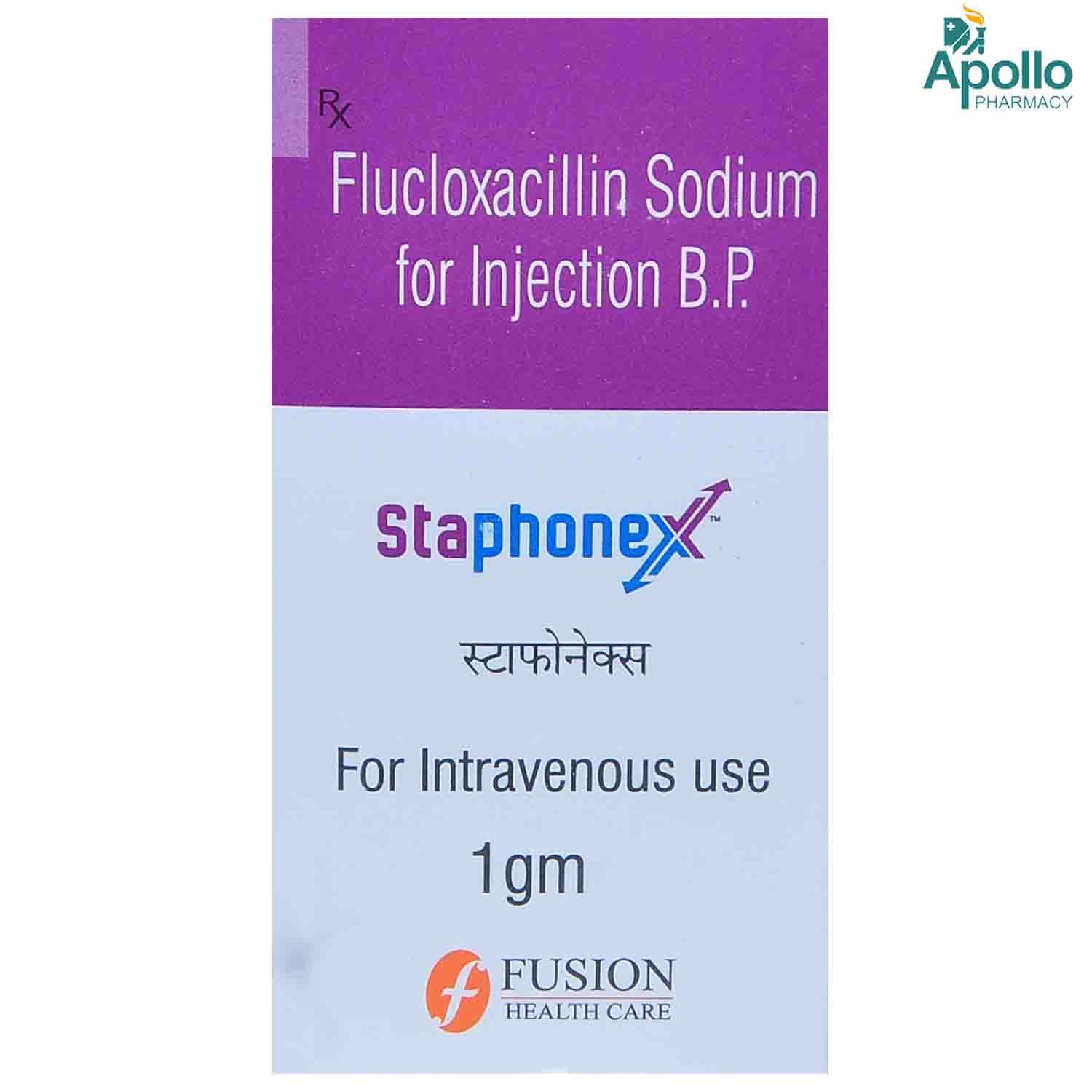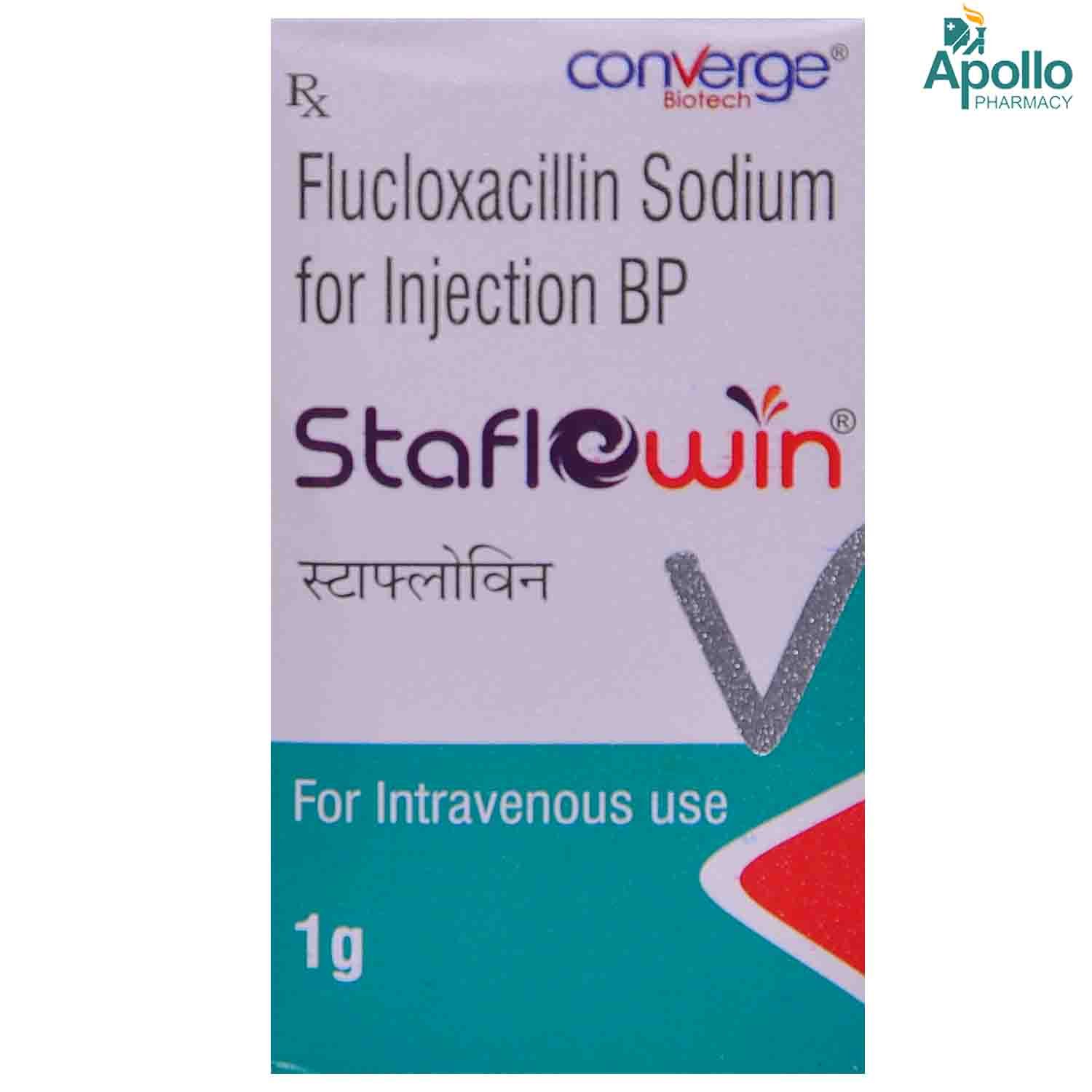Staphonex 1 gm Injection



MRP ₹702
(Inclusive of all Taxes)
₹105.3 Cashback (15%)
know your delivery time
Provide Delivery Location
Composition :
Manufacturer/Marketer :
Consume Type :
Expires on or after :
Return Policy :

Secure Payment

Trusted by 8 Crore Indians

Genuine Products
Therapeutic Class
Country of origin
Manufacturer/Marketer address
Author Details
We provide you with authentic, trustworthy and relevant information
Disclaimer
Alcohol
Safe if prescribed
No interactions were found. However, as a precautionary measure, you are recommended not to consume alcohol along with Staphonex 1 gm Injection to avoid unpleasant side effects.
Pregnancy
Consult your doctor
Inform your doctor before taking the Staphonex 1 gm Injection if you are pregnant. Your doctor will weigh the benefits and potential risks before prescribing Staphonex 1 gm Injection.
Breast Feeding
Consult your doctor
Inform your doctor before taking the Staphonex 1 gm Injection if you are breastfeeding. Your doctor will weigh the benefits and potential risks before prescribing Staphonex 1 gm Injection.
Driving
Safe if prescribed
Staphonex 1 gm Injection has no or negligible influence on driving or operating machines.
Liver
Consult your doctor
If you have liver problems, inform your doctor before receiving the Staphonex 1 gm Injection. Your doctor may suggest liver function tests during the treatment with Staphonex 1 gm Injection.
Kidney
Consult your doctor
If you have a history or evidence of any kidney-related diseases, inform your doctor before taking the Staphonex 1 gm Injection. Your doctor may suggest tests to monitor your kidney function. Dose adjustment may be necessary.
Children
Safe if prescribed
Please consult your doctor. Your doctor may prescribe the dose of Staphonex 1 gm Injection based on the age and condition of your child.
Product Substitutes
About Staphonex 1 gm Injection
Staphonex 1 gm Injection belongs to a class of medicines called 'antibiotics'. It treats various bacterial infections, including bone infections (osteomyelitis) and infections of the heart lining (endocarditis). On the other hand, it is used to prevent infections during major surgical procedures such as heart and lung surgeries (cardiothoracic surgery) and bone, joint, and muscle operations. A bacterial infection is a condition in which harmful bacteria grow in the body and cause infection. It can infect any part of the body and multiply very quickly.
Staphonex 1 gm Injection contains 'Flucloxacillin Sodium'. It works by preventing the bacteria's cell wall formation, which is necessary for their survival. Thereby, Staphonex 1 gm Injection kills the bacteria and effectively treats various bacterial infections.
Staphonex 1 gm Injection will be administered by a qualified healthcare professional. Your doctor will advise the duration based on your medical condition. In some cases, you may experience redness and pain around the area of infusion, rash, itching, joint pain, hallucinations, anaemia, diarrhoea, nausea and vomiting. Most of these side effects of Staphonex 1 gm Injection do not require medical attention and gradually resolve over time. However, if the side effects persist or worsen, please consult your doctor.
Inform your doctor if you are allergic to penicillin, flucloxacillin Sodium, or any other medicines in the past if you have had liver or kidney problems, or vaccinated recently. It is essential to inform the healthcare professional if you are pregnant or breastfeeding. Do not take any other medicines, including herbal remedies, vitamins, or supplements without first consulting your doctor.
Uses of Staphonex 1 gm Injection
Medicinal Benefits Mweb
Key Benefits
Staphonex 1 gm Injection contains 'Flucloxacillin Sodium,' an antibiotic used to treat a wide range of bacterial infections, including bone infections (osteomyelitis) and infections of the heart lining (endocarditis). It is also used to prevent infections that can occur during major surgical procedures such as heart and lung operations (cardiothoracic surgery) and bone, joint, and muscle operations (orthopaedic surgery). Staphonex 1 gm Injection acts by stopping bacteria from forming cell walls, which are required for survival. As a result, Staphonex 1 gm Injection destroys the germs and successfully treats various bacterial infections.
Directions for Use
Side Effects of Staphonex 1 gm Injection
- Redness and pain around the area of infusion
- Allergic reactions
- Feeling sick or nausea
- Anaemia
- Joint pains
- Tender red lumps under the skin
- Vomiting
- Hallucinations
- Diarrhoea
Drug Warnings
If you are sensitive to cephalosporins, penicillin, or any other -lactam antibiotic, it is not suggested that you use Staphonex 1 gm Injection. If you previously received flucloxacillin Sodium and developed jaundice (yellow skin and whites of the eyes) or other liver problems. Before using this medication, you should notify your doctor if you are pregnant or attempting to conceive. You should not breastfeed if you are receiving Flucloxacillin Sodium Injection. If you are breastfeeding while receiving Flucloxacillin Sodium Injection therapy, inform your doctor. Flucloxacillin Sodium, especially in large doses, may lower potassium levels in the blood (hypokalaemia). During flucloxacillin Sodium therapy with greater doses, your doctor may monitor your potassium levels on a frequent basis.
Drug-Drug Interactions
Drug-Drug Interactions
Login/Sign Up
Drug-Food Interactions
Drug-Food Interactions
Login/Sign Up
Drug-Diseases Interactions
Drug-Diseases Interactions
Login/Sign Up
Drug-Drug Interactions Checker List
- PROBENECID
- METHOTREXATE
- CHLORAMPHENICOL
- TETRACYCLINE
- ESTROGEN
Habit Forming
Special Advise
Inform your healthcare professional that you are taking Staphonex 1 gm Injection if you are undergoing urine tests or blood tests because it may affect the results.
Diet & Lifestyle Advise
- Probiotics should be taken after taking the full course of Staphonex 1 gm Injection to restore healthy bacteria in the intestines that may have been killed. Taking probiotics after antibiotic treatment can reduce the risk of antibiotic-associated diarrhoea. Certain fermented foods like yoghurt, cheese, sauerkraut, and kimchi can help restore the intestine's good bacteria.
- Include more fibre-enriched food in your diet, as it can be easily digested by your gut bacteria, which helps stimulate their growth. Whole grains bread and brown rice should be included in your diet.
- Avoid intake of alcoholic beverages with Staphonex 1 gm Injection as it can make you dehydrated and affect your sleep. This can make it harder for your body to aid Staphonex 1 gm Injection in fighting infections.
- Make sure you drink plenty of water or other fluids every day while taking Staphonex 1 gm Injection.
All Substitutes & Brand Comparisons
RX
Out of StockStaflocrit 1 gm Injection 1's
Biocrit Healthcare Pvt Ltd
₹499
(₹499.0 per unit)
21% CHEAPERRX
STAFLOWIN 1GM INJECTION
Converge Biotech Pvt Ltd
₹555
(₹499.5 per unit)
20% CHEAPERRX
Out of StockFlulen Injection
₹749
(₹674.1 per unit)
6% COSTLIER

Have a query?
Buy best Infections & Infestation products by
Cipla Ltd
Macleods Pharmaceuticals Ltd
Alkem Laboratories Ltd
Lupin Ltd
Abbott India Ltd
Sun Pharmaceutical Industries Ltd
Mankind Pharma Pvt Ltd
Micro Labs Ltd
Aristo Pharmaceuticals Pvt Ltd
FDC Ltd
Intas Pharmaceuticals Ltd
Glenmark Pharmaceuticals Ltd
Ipca Laboratories Ltd
Torrent Pharmaceuticals Ltd
Zydus Healthcare Ltd
Biochem Pharmaceutical Industries Ltd
Zuventus Healthcare Ltd
United Biotech Pvt Ltd
Hetero Drugs Ltd
Emcure Pharmaceuticals Ltd
Alembic Pharmaceuticals Ltd
Indoco Remedies Ltd
Fusion Health Care Pvt Ltd
Dr Reddy's Laboratories Ltd
Leeford Healthcare Ltd
Cadila Healthcare Ltd
Wockhardt Ltd
Zydus Cadila
GlaxoSmithKline Pharmaceuticals Ltd
Morepen Laboratories Ltd
Blue Cross Laboratories Pvt Ltd
Cadila Pharmaceuticals Ltd
Converge Biotech Pvt Ltd
Elder Pharmaceuticals Ltd
Hetero Healthcare Pvt Ltd
Pfizer Ltd
AAA Pharma Trade Pvt Ltd
Gufic Bioscience Ltd
Mylan Pharmaceuticals Pvt Ltd
Corona Remedies Pvt Ltd
Wallace Pharmaceuticals Pvt Ltd
Apex Laboratories Pvt Ltd
Medishri Healthcare Pvt Ltd
Akumentis Healthcare Ltd
Alniche Life Sciences Pvt Ltd
Hegde & Hegde Pharmaceutica Llp
Veritaz Healthcare Ltd
Ranbaxy Laboratories Ltd
Koye Pharmaceuticals Pvt Ltd
Shreya Life Sciences Pvt Ltd
Overseas Health Care Pvt Ltd
Biocon Ltd
Indchemie Health Specialities Pvt Ltd
Medley Pharmaceuticals Ltd
Brinton Pharmaceuticals Ltd
J B Chemicals & Pharmaceuticals Ltd
Unifaith Biotech Pvt Ltd
Ajanta Pharma Ltd
Biochemix Health Care Pvt Ltd
Natco Pharma Ltd
Samarth Life Sciences Pvt Ltd
Unichem International
Laborate Pharmaceuticals India Ltd
Unipark Biotech Pvt Ltd
Zymes Bioscience Pvt Ltd
Indiabulls Pharmaceuticals Pvt Ltd
Neon Laboratories Ltd
Vasu Organics Pvt Ltd
DR Johns Lab Pharma Pvt Ltd
East West Pharma India Pvt Ltd
La Renon Healthcare Pvt Ltd
Medgen Drugs And Laboratories Pvt Ltd
Novartis India Ltd
Canixa Life Sciences Pvt Ltd
Icarus Health Care Pvt Ltd
Lincoln Pharmaceuticals Ltd
Celon Laboratories Pvt Ltd
Concept Pharmaceuticals Ltd
Klm Laboratories Pvt Ltd
Nicholas Piramal India Ltd
Systopic Laboratories Pvt Ltd
Yuventis Pharmaceuticals
Capital Pharma
German Remedies Ltd
Pristine Pearl Pharma Pvt Ltd
Unison Pharmaceuticals Pvt Ltd
Aurz Pharmaceutical Pvt Ltd
Clover Health Care Pharma
Kepler Healthcare Pvt Ltd
Allites Life Sciences Pvt Ltd
Auspharma Pvt Ltd
Intra Life Pvt Ltd
Jolly Healthcare
Linux Laboratories Pvt Ltd
Ozone Pharmaceuticals Ltd
Cachet Pharmaceuticals Pvt Ltd
Comed Chemicals Ltd
Delcure Life Sciences Ltd
Fresenius Kabi India Pvt Ltd
Khandelwal Laboratories Pvt Ltd





